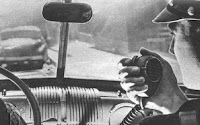Was this expression ever part
of police radio dispatch lexicon? Many
think so. However, Gerald Morris,
Superintendent for the NYPD in 1937 described it this way:
 |
| Calling all cars! |
We’ve all heard this phrase,
and assumed that was used in the early days of dispatching patrol cars. It origins perhaps is based from an old
radio program, as well as movies and later television.
From 1933 to 1937, there was
an early radio broadcast show called “Calling All Cars” [sort of like a Dragnet
broadcast]. Each episode began with a simulated
radio dispatch call that was introduced by a LA Police officer. The show was a production of a true crime
story of the day, describing the crime, telling how the crime was solved and
how justice was served.
Early Police Dispatching
At the turn of the 20th
century, a policeman on beat would use a telephone call box on the
street to
call headquarters for assignments or for backup if needed. [Sometimes whistles
were used to alert colleagues in the nearby area].
 |
| Police Call Box |
This period also saw the
emergence of the automobile, the automobile significantly changed how police
conducted their operations, but also made contact with headquarters challenging. In many places, the only way to communicate
with headquarters was to install a lamp on a pole or building near a downtown area
to signal officers. A roving patrol car would periodically drive by to check
the status of the lamp. If the lamp was on, they would stop and call
headquarters using a telephone call box.
Within 20 years, the radio too
became a powerful weapon against crime.
Detroit first started using radio in 1927. By the mid 1930s, most large US
municipal police departments were using radio for police work while many
smaller communities were ultimately planning their own systems.
Radio changed things – while it
took 20 minutes or more for an officer to respond to a call using the call box
system, the radio reduced this to about 45 seconds [Thomas Rochester, NYPD
radio engineer]. The automobile and the
radio forever changed how law enforcement conducted operations. In a 1990’s study, it was shown that police
officers valued their radio more than they valued their service revolver.
Commercial broadcast radio
first surfaced in 1920, with KDKA in Philly being the first to enter. Broadcast saw incredible growth in the 1920s,
and it didn’t take long before law enforcement officials saw its possibilities
to fight crime.
During these early days of
broadcast radio, some police departments used this medium to alert patrol
officers of crimes in progress. The commercial broadcaster would periodically
interrupt their regular entertainment programming to transmit urgent messages
to officers on patrol.
Although this method was effective,
mixing police emergency messages during a broadcast created problems for the
police. People listening to the police broadcast showed up at crime scene - sometimes
before the police did. Of course, some criminals
also listened police broadcasts to assist in evading police.
The City of Detroit spent
nearly the 1920s decade working on radio problems. The early systems were one-way
radio – a dispatcher transmitting messages to vehicles on patrol. Vehicles
could not communicate back. However, in 1932 the City of Bayonne, NJ was the
first US police department to install transmitters in their patrol cars thus
having two-way communications.
First Use of Radio for Law Enforcement
Just a few short years earlier
in 1901, Marconi transmitted his first transatlantic wireless message using
Morse code – the letter “S”. Marconi and
early wireless exploration focused on ship to shore communications. By 1907,
ships were beginning to install wireless sets on their ships. Cargo and
passenger shipping companies saw this wireless telegraphy was not only essential
assisting in the prevention of sea catastrophes, but also to help in sea rescues.
Wireless telegraphy was also used to provide ship travellers with daily news.
Ultimately, the Titanic [1912]
proved that wireless communication was critical to shipping and all ships
thereafter were required to have wireless telegraphy.
 |
| Hawley Crippen |
The press was also alerted [by
leaks] and the public was able to follow Crippen’s activities throughout journey
through press reports, as it took several weeks for the ship to traverse the
Atlantic. The Captain even made friends
with the Doctor and his companion, making several reports of their encounters
using his shipboard wireless set. Many
consider this the first tabloid type drama, as the public was fascinated with
this story because of the gruesome event and the ongoing Captain’s reports;
kind of the precursor to today’s TV broadcast sensualizing the news event while
it happens.
The story got lots of internationally
attention and was considered a very important event for the upsurge of Marconi’s
wireless technology.
Crippen’s wife, Cora, was an ambitious
performer and opera singer, and used her sexual
attractions to advance her
theatrical and singing career. Cora mysteriously
disappeared and Crippen told friends that she had gone back to the United
States, had taken ill and died. He then foolishly invited his secret lover to
move in with him. It was thought that Cora
probably had been murdered, dismembered; some say fileted, and then burned. Parts
of the body were found. Crippen was arrested, then tried in a London court and was
later hanged. In recent times, with DNA
testing, it appears that Crippen may not have murdered Cora.


No comments:
Post a Comment